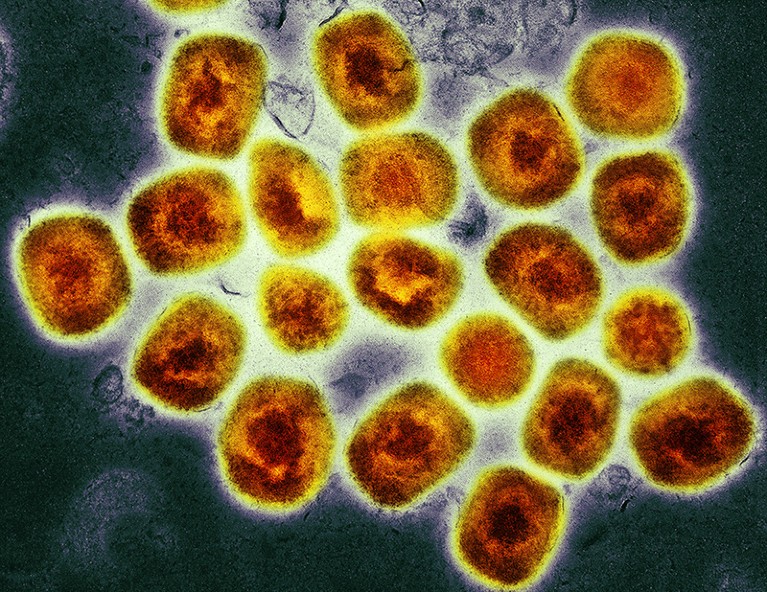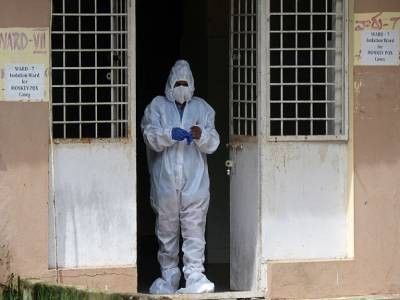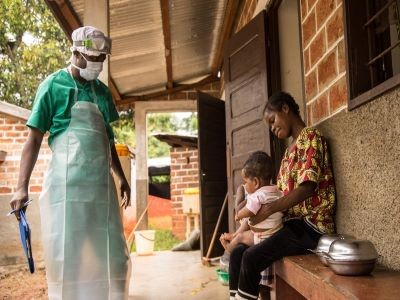
Monkeypox virus (particles shown in this colorized transmission electron microscope image) is a DNA virus that readily detects and repairs small mutations in its genome, thus evolving more slowly than other pathogens.Credit: National Institutes of Health/Science Photo Library
While researchers at the Minnesota Department of Health in St. Paul were sequencing monkeypox virus samples a few months ago, they made a startling discovery. In a sample collected from an infected person, a large part of the virus genome was missing and another part had been moved to a completely different place in the sequence.
Crystal Gigante, a microbiologist at the US Centers for Disease Control and Prevention in Atlanta, Georgia, was called in to help examine the mutations. She and her colleagues found similar deletions and rearrangements in a handful of other monkeypox genomes collected in the United States, according to a report they published September 17 on the non-peer-reviewed preprint server bioRxiv.

How deadly is monkeypox? what scientists know
Although scientists are not alarmed, they are monitoring the situation carefully to understand why the disturbances have appeared and what they could mean for the global outbreak of monkeypox. These mutations are a stark reminder that even poxviruses, which are DNA viruses that tend to evolve more slowly than RNA viruses, such as the SARS-CoV-2 coronavirus, will change over time, says Elliot Lefkowitz, a computational virologist at the University of Alabama at Birmingham. And the more the monkeypox virus is transmitted between humans, he adds, the more opportunity it has to evolve.
The mutations evaluated by Gigante were not the single-letter alterations that scientists are used to seeing in the SARS-CoV-2 genome. In some cases, entire genes had disappeared: a stretch of about 7% of the genome was missing in a sample from an infected person in Florida. But it’s too early to say whether the mutations are beneficial, neutral or harmful to the virus, says Lefkowitz. If health officials see an increase in the number of virus samples that have these mutations, that could be a possible sign that they are helping the virus spread.
Mutational Strategies
The large deletions and rearrangements first reported in Minnesota did not surprise Eneida Hatcher, an evolutionary virologist at the National Center for Biotechnology Information in Bethesda, Maryland. In 2015, she co-authored a study2 with Lefkowitz showing that such mutations are common in most poxviruses, and that most of the genes they disrupt are located towards the final or terminal regions of the viral genome. “It was really nice to see some of the mutational strategies we’ve seen in the past replicated,” says Hatcher.

Why scientists fear monkeypox will spread to wild animals
Orthopoxviruses, a genus of poxviruses that includes monkeypox virus and smallpox virus, which causes smallpox, share a core set of about 174 genes at the center of their genomes. But its terminal regions are more variable and contain fewer essential genes. Some of the genes in these regions are thought to encode proteins that help disarm host immune responses and are designed to infect specific hosts, Lefkowitz says. This underlies one hypothesis as to why variola became adept at infecting humans: Over thousands of years, an earlier version of the virus might have lost genes from its ends that allowed it to infect a wide range of animal species. and eventually became a specialist in infecting humans. (Before smallpox was eradicated, it killed three out of ten infected people.)
Some scientists are concerned that a similar situation could arise with monkeypox, which is now more widespread; it can infect many mammals, including several species of rodents and humans.
But predicting how the behavior of the monkeypox virus will change as it mutates is difficult because researchers have yet to characterize the function of many genes in its large genome. For example, although researchers first discovered that two strains of the monkeypox virus were spreading in Africa more than 17 years ago, they are still struggling to determine precisely which genes are responsible for the difference in death rate. between the two, says Lefkowitz. The mortality rate of one of them, clade I, which predominates in Central Africa, is around 10%. Clade II, which circulates in West Africa, has a mortality rate of about 1% to 3%.
Genome Collaboration
By analyzing monkeypox sequences, researchers are also learning more about how the virus might have caused the global outbreak. Scientists have noted a pattern of single-letter mutations, apart from the changes first detected in Minnesota, that appears to be a genetic fingerprint of the ongoing battle between the human immune system and the virus. Using the data collected so far to roughly calculate the number of these mutations expected each year, they estimated that the strain responsible for the global outbreak jumped from animals to humans in early 2016. That’s more than a year and a half before it the strain was detected. first detected in humans by Nigerian health officials, who declared an outbreak in their country that has never fully ended.

Monkeypox in Africa: the science the world ignored
The good news is that while the monkeypox virus continues to evolve, no mutations have affected the part of its genome that encodes a protein targeted by tecovirimat, an antiviral drug being tested against monkeypox. in humans. But eventually problems could arise in diagnostic tests. To detect monkeypox virus in samples, technicians perform polymerase chain reaction (PCR) to detect target sequences in the virus genome. Gigante and his colleagues found that one of two copies of a monkeypox target had been eliminated in one of the samples they had analyzed. Although the PCR test returned a positive result, the authors warn that this type of mutation could eventually render it ineffective.
The worldwide attention on monkeypox will help researchers understand not only the virus that causes the disease, but also poxviruses in general, says Hatcher. Before this year, only about 100 nearly complete monkeypox genomes existed, she says. Now around 2000 have been deposited in established international repositories. “I am very happy to see that the international collaborative attitude toward surveillance and genome sequencing” has continued beyond the COVID-19 pandemic, she says.
Source: news.google.com